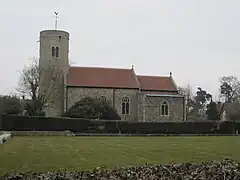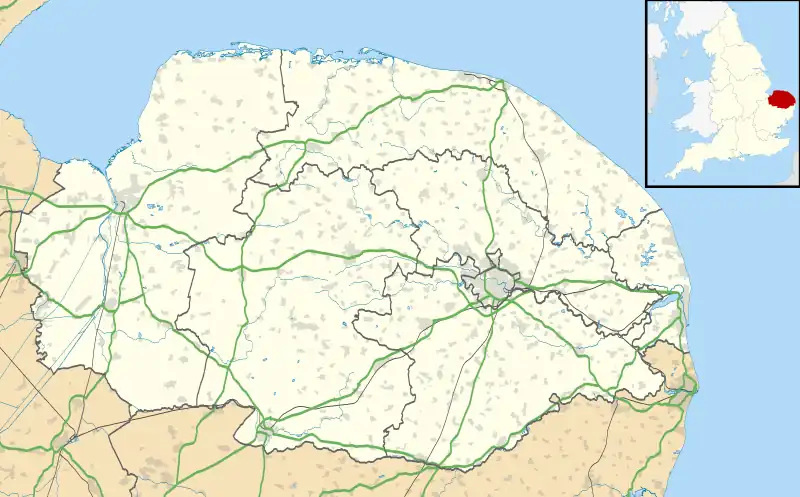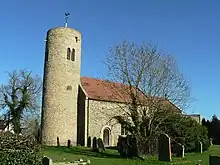Gissing, Norfolk
Gissing /ˈɡɪsɪŋ/ is a village and civil parish in Norfolk, England, about 6 miles (9.7 km) north of Diss and 15 miles (24 km) south-west of Norwich.
| Gissing | |
|---|---|
 St Mary, Gissing | |
 Gissing Location within Norfolk | |
| Area | 8.11 km2 (3.13 sq mi) |
| Population | 252 (2011) |
| • Density | 31/km2 (80/sq mi) |
| OS grid reference | TM146855 |
| • London | 83 miles (134 km) |
| Civil parish |
|
| District | |
| Shire county | |
| Region | |
| Country | England |
| Sovereign state | United Kingdom |
| Post town | DISS |
| Postcode district | IP22 |
| Dialling code | 01379 |
| Police | Norfolk |
| Fire | Norfolk |
| Ambulance | East of England |
| UK Parliament | |

History
Gissing's name is of Anglo-Saxon origin and derives from the Old English for Gyssa's or Gyssi's people.[1]
In the Domesday Book, Gissing is listed as a settlement of 55 households in the hundred of Diss. In 1086, the village was divided between the estates of King William, Robert Malet, Roger Bigod and the Abbey of St. Edmund.
Gissing Hall falls within the parish, which is a Fifteenth Century mansion house. Today the hall operates as a hotel and restaurant.
On the 29th January 1944, two Consolidated B-24 Liberators of the United States Army Air Force collided in mid-air above Gissing whilst assembling for a strategic bombing raid on Frankfurt. A total of 14 aviators were killed in the collision.[2]
Geography
According to the 2001 Census, Gissing had a population of 254 people living in 95 households,[3] by the 2011 Census this had fallen to 252 people living in 109 households.[4] Furthermore, the parish has a total area of 3.13 square miles (8.1 km2).
Gissing falls within the constituency of South Norfolk and is represented at Parliament by Richard Bacon MP of the Conservative Party. For the purposes of local government, the parish falls within the district of South Norfolk.
St. Mary's Church
Gissing's parish church is one of Norfolk's 124 existing round-tower churches and is a Grade I listed structure.[5]
In 1209 there was a rectory; in 1271, a vicarage was endowed with "all the offerings, the tithes of the mills, a vicarage-house and meadow, and an acre of land adjoining, and twenty acres more of the church's free land, and all other small tithes, except hay, which, with all the corn tithes, and the rest of the glebe, together with the rectory manor, and all its appurtenances, were to belong to the prior himself."[6]
There are monuments to members of the Kemp family, including Sir Robert Kemp (d.1710) and both his wives. His memorial is by Edward Stanton. The monument to Sir John Kemp (d.1815) is by the London sculptor Charles Regnart.[7]
War Memorial
Gissing's war memorial takes the form of a rough-hewn Celtic cross with a sword of sacrifice and is located just outside of St. Mary's Churchyard. The memorial lists the following names for the First World War:
- Sgt. Cyril Leathers (d.1915), 9th Bn., Royal Norfolk Regiment
- Pvt. George Sandy (d.1918), 12th Bn., British West Indies Regiment
- Pvt. E. Victor Leathers (d.1916), 4th Bn., Grenadier Guards
- Pvt. Robert Lockwood (1881-1918), 10th Bn., Hampshire Regiment
- Pvt. Reginald F. Woolsey (1890-1917), 7th Bn., London Regiment
- Pvt. John Randle (1889-1915), 7th Bn., Royal Norfolk Regt.
- Pvt. Benjamin M. Ringer (1896-1918), 9th Bn., Royal Norfolk Regt.
- Pvt. Harold A. Higgins (1873-1917), 2nd Bn., Rhodesia Regiment
- Leonard C. Higgins
And, the following for the Second World War:
- Sgt. Wilfred T. Francis (1922-1944), No.42 Operational Training Unit, Royal Air Force
- Pvt. Albert A. Hammond (1915-1943), Royal Army Ordnance Corps
References
- University of Nottingham. Retrieved May 30, 2023. http://kepn.nottingham.ac.uk/map/place/Norfolk/Gissing
- Aviation Safety Network. Retrieved May 30, 2023. http://aviation-safety.net/wikibase/wiki.php?id=101061
- "Gissing parish information". South Norfolk Council. 22 March 2006. Archived from the original on 29 August 2008. Retrieved 20 June 2009.
- Office for National Statistics. Retrieved May 30, 2023. https://www.nomisweb.co.uk/reports/localarea?compare=E04006550
- "Images of England".
- Blomefield, Francis (c. 1736). . Vol. 1. London (published 1805–1810).
- Dictionary of British Sculptors 1660-1851, Rupert Gunnis